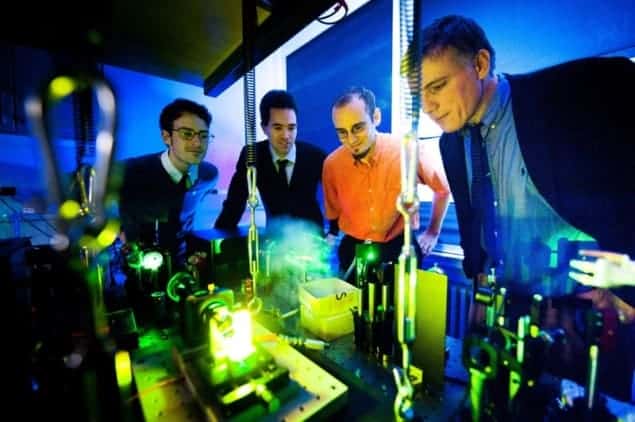
Many physicists believed it could not be done, but now a team in Germany has created a Bose–Einstein condensate (BEC) from photons. BECs are formed when identical bosons – particles with integer spin – are cooled until all particles are in the same quantum state. This means that a BEC comprising tens of thousands of particles behaves as a single quantum particle.
The first BEC was made in 1995 by cooling a cloud of rubidium atoms to near absolute zero and today such condensates are routinely used to study a variety of quantum phenomena. However, few physicists had contemplated making a BEC from the most common boson in the universe – the photon. This is because photons are easily created or destroyed when they interact with other matter, which makes it very difficult to cool a fixed number of photons such that they form a condensate.
But now Martin Weitz and colleagues at the University of Bonn in Germany have devised a way of isolating and cooling photons. Although they cannot capture a fixed number of photons, the number fluctuates around a mean value, allowing the ensemble to be characterized using conventional BEC theory.
Trapped between two mirrors
The team trapped its photons between two concave mirrors that are separated by a maximum of 1.5 µm. This distance (to within an integer number) defines the maximum wavelength – or minimum energy – of a photon that is confined longitudinally within the cavity between the mirrors. The cavity is filled with a dye that is held at room temperature – and, crucially, the thermal energy of the dye is about 1% of the photon energy.
This large energy difference means that it is highly unlikely that additional photons will emerge from the dye, or that the dye will completely absorb a photon. Instead, the photons collide with the dye molecules, giving up or receiving small amounts of energy. These interactions cool the photons to room temperature – which is cold enough to create a photon BEC – while preserving the number of photons.
The team created the BEC by firing a laser into the cavity to fill it with photons. The laser was then kept on throughout the experiment to make up for photons that were lost at the mirrors and imperfections in the cavity. Some of the photons pass through one of the mirrors to a spectrometer, which measures the distribution of photon energies in the cavity. At low laser intensities the cavity contains a broad range of photon energies with a sharp cut-off at the cavity’s minimum energy.
Critical number of photons
When the laser intensity is increased, the number of photons in the cavity rises and the broad distribution endures until the photon number reaches about 60,000. Above this critical value, according to Weitz, the photon gas is dense enough for a BEC to form – much like a liquid drop condensing in a gas.
The team knows that the BEC has formed because a large peak in the photon energy spectrum emerges just above the cut-off energy. This peak corresponds to a large number of photons piling into the lowest energy state of the cavity. As the laser intensity is increased further, the number of photons in the BEC reaches millions.
To convince themselves that the peak is related to a BEC, rather than the cavity behaving like a laser, the researchers repeated the experiment at several different separation distances. They found that the peak always emerged at the same photon density – something that would not be seen in a laser, according to Weitz.
Small effective mass
The cavity has a planar design, which means that the photons are confined to two dimensions. As a result of the longitudinal confinement, they behave as if they are particles with an “effective mass” corresponding to the cut-off energy. This mass is still extremely small, which is why photons will form a BEC at room temperature and don’t need to be cooled to micro-Kelvin temperatures like atoms.
Interactions between the photons are much weaker than those between atoms and this means that photons can form a true 2D BEC. Atoms, on the other hand can only form a 3D BEC.
According to Weitz, creating thermalized light doesn’t necessarily require a laser and devices could be “pumped” by other light sources – including the Sun. As a result, he believes they could be used to shrink the size of solar cells by concentrating light within devices. He also believes BEC could be used to build sources of coherent light that don’t involve a laser.
The research is described in Nature 468 545 and, writing in the same issue of the journal, James Anglin of the Technical University of Kaiserslautern calls it “a landmark achievement”. He also points out that the experiment shows how “physics is the art of interchangeable” because in addition to showing the wave-like properties of atoms, BECs have now been used to show particle-like properties of light.



